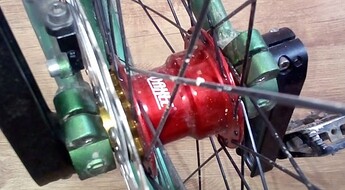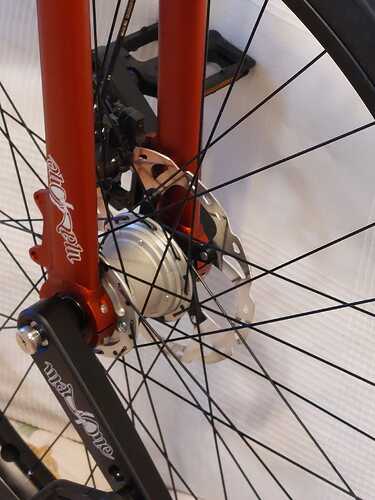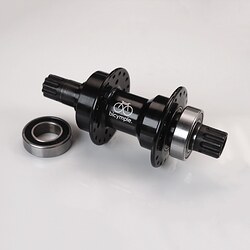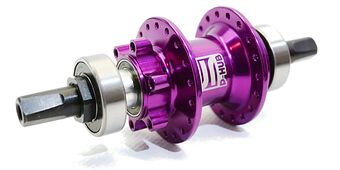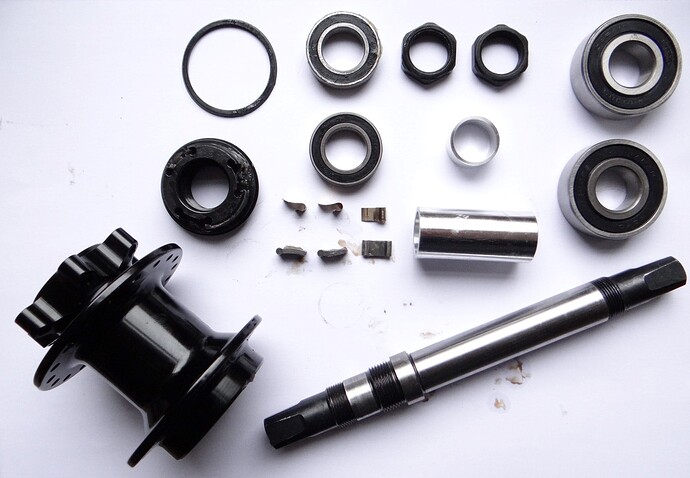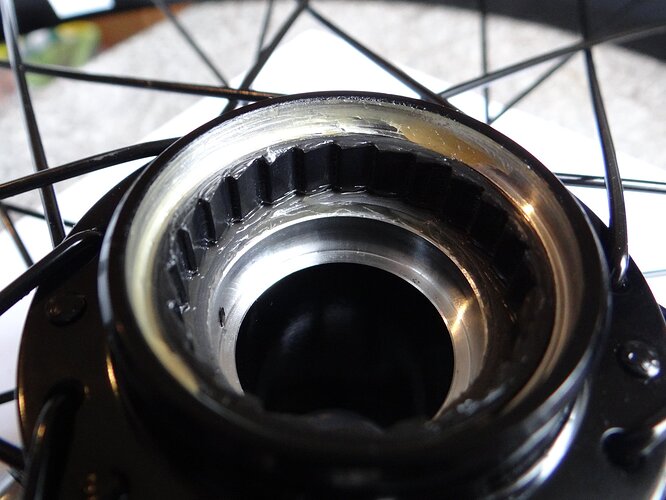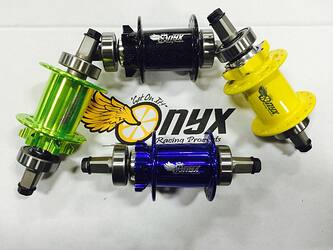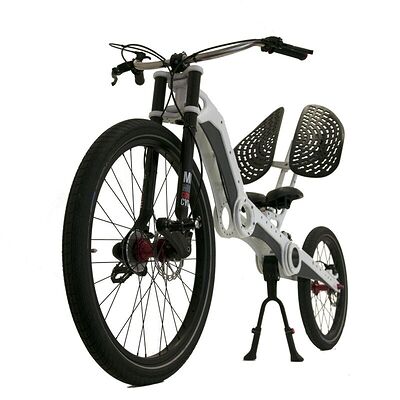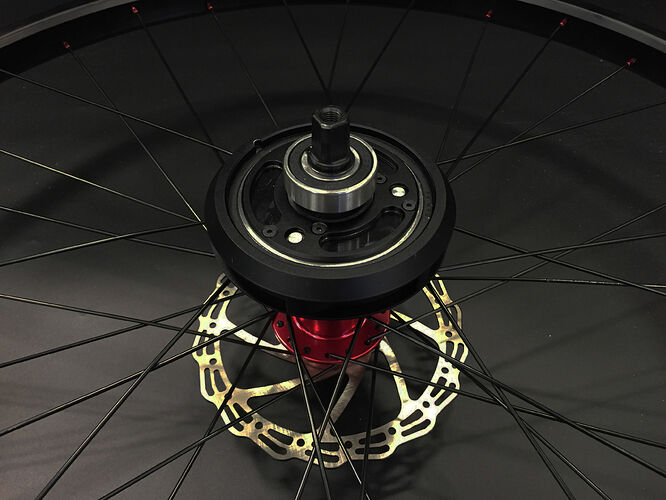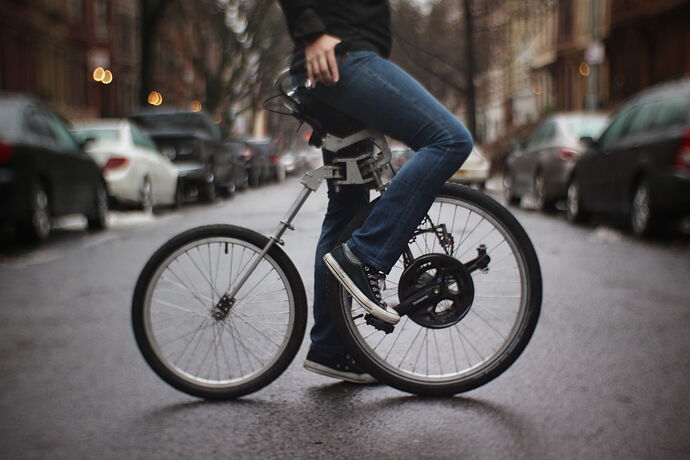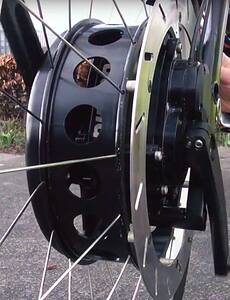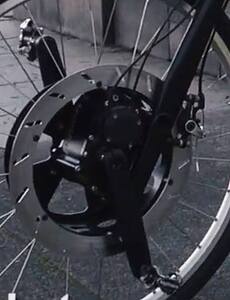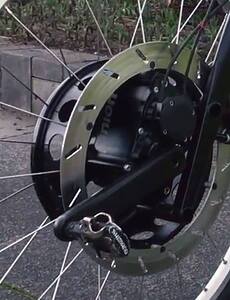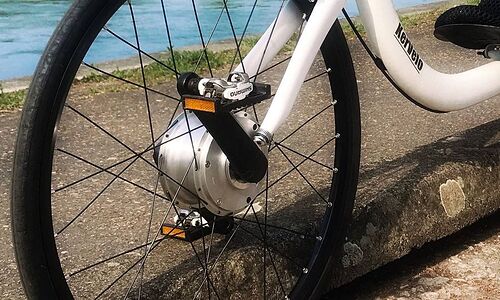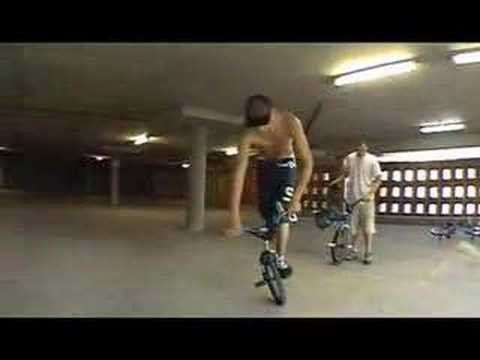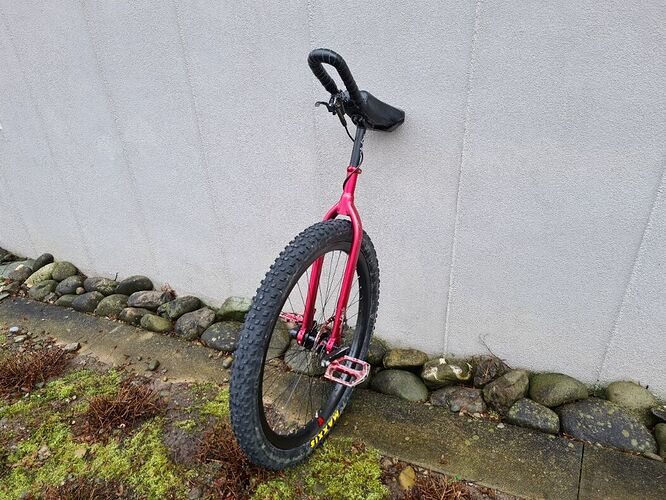Please post in this thread anything freewheel-related, especially anything informational that’s missing from this post so that it can be updated.
General Freewheel FAQ
Terminology - What do we mean by a freewheel unicycle?
A freewheel (or freewheeling) unicycle, as the name suggests, is a unicycle that freewheels. These typically use a hub with a clutch, which only engages when you’re pedaling forwards.
This means that when you stop pedaling, the unicycle wheel continues to rotate.
Unlike a BC (impossible) wheel that freewheels in both directions and has no method of propulsion or a seat, “freewheel unicycle” normally refers to a unicycle with a seat and pedals.
Some people have built freewheel unicycles without pedals rather BMX pegs to put your feet on, but they are even more uncommon than ones with pedals.
Why would someone want a freewheeling unicycle?
Like most questions about unicycling, the short answer is “why not?”
The longer answer is that it’s another skill to learn, and practice provides rather a different experience and allows you to ride in a way that no other unicycles do.
There is also the potential for new riding styles and tricks that are impossible on a fixed wheel unicycle.
Are they harder to ride than a fixed wheel unicycle?
Yes.
Where can I buy one?
Right now complete freewheel unicycles are available from Mad4One with their switchable Flik-Flok hub (see below for details of this), or alternatively the Pipifax freewheeling hub is available from Qu-Ax and can likely be built into your unicycle of choice by your favourite unicycle shop.
Other freewheel hub options are primarily only available second hand, although they occasionally appear for sale
Building a Freewheel Unicycle FAQ
What size?
People have built freewheels from 20" to 36" so go with whatever you think will work for you. Generally 24"-27.5" would be recommended if you’ve not got a specific size in mind already.
Which frame?
Any 100mm bearing spacing frame with disk brake mounts on the left (internal) side. Nimbus Oracle (up to 29" and Universal Disk 36"), Qu-Ax RGB (24" and larger), Qu-Ax QX Series (24" and larger), KH double disk frames (2023 models), Mad4One Muni/URC Muni, Flansberrium etc.
KH frames from before 2023 are not compatible as the disk mount is on the wrong side, although you can weld a tab onto the appropriate size - UDC (UK) sells a kit for this use with the Schlumpf BrakeFast.
D’brake mounts can be used, but are not generally recommended due to flex and vibration that is less than ideal on a freewheel. The now included stiffener plate is an improvement but not a perfect fix.
Which hub?
It should go without saying that to build a freewheel unicycle, you need a freewheeling hub.
You can either buy a unicycle specific freewheel hub, or think a bit outside of the box.
For unicycle specific hubs your options are either the Qu-Ax Pipifax sprag clutch freewheel hub (Q-Axle crank interface), or the Mad4One Flik-Flok switchable fixed/freewheel hub (ISIS crank interface).
In the non-unicycle hub category the best options are either the the Bicymple 1:1 freewheel hub (ISIS crank interface), or the JR Drift Trikes P-Hub (square taper crank interface).
This is down to the number of clutch engagement points (24 for each), and so far the lack of failures of these hubs.
Alternatively the Nimbus Drift Trike Disk Hub, or Madazz Trikes Freewheeling Pedal Hub (both square taper crank interface). These are identical in design, and although they’re not quite as good as the JR, plenty of riders use them with no issue. Hardcore riders do have a habit of splitting the hub shell in two though, especially when riding with long cranks, so be careful!
There are other options, but are generally not recommended for a variety of reasons - see the hubs section below.
Can I just modify my existing unicycle/wheelset?
Yes, and many people have done exactly this. If going from a stock 100mm Nimbus Oracle or KH wheelset, the spoke lengths required are close enough that you can generally do a straight hub swap (to either the aforementioned Nimbus/Madazz, JR, or Bicymple hubs). Other wheels or hubs may require new spokes depending on their original hub dimensions.
Can I build without a brake?
Yes, but the same hubs would be recommended if you can get them. Obviously then you have more frame options if you’re not considering adding a brake in the future. You could even use a frame designed for square taper hubs with 40mm bearings (see next question).
Do I need to do anything else to make this work?
If you’re using a standard frame designed for 42mm bearings (designed for ISIS or Q-Axle hubs) then for all of the square taper hubs you will either need 1mm bearing shims (sometimes available from UDC), or replacement bearings (17x42x12 - often available on eBay). DIY shims are possible, and can even be 3D printed without too much worry as the whole part is contained and in compression.
If you’re using the Bicymple 1:1 ISIS hub, then you must ensure that you use crank spacers. This is even more important than on a fixed wheel because not only will you likely damage your cranks without, the hub itself will come apart if the spacers are not there to hold it all together. Spacer length will depend on your specific crank choice (~2-3mm less than the distance between the bearing and the inside of a crank pushed on by hand).
What cranks, at what length?
For either the Nimbus/Madazz, JR P-hub, or other drift trike hubs, you will need square taper (cotterless) cranks.
For the Bicymple hub Mad4One hub, you need standard ISIS cranks (common on most higher end unicycles).
For the Qu-Ax hub you need Q-Axle (or Shimano Hollowtech II) cranks.
As a general rule, go for one size shorter on the length than you would go with a fixed wheel. Extra length is only useful for uphill as if you want to slow down, your brake has to do all of the work, and smooth pedalling is pretty critical on a freewheel.
Can I use x/y/z part or do x/y/z not mentioned in this FAQ?
Absolutely give it a try and let us know how it goes! Freewheel unicycling is very much a new part of our sport and we’re all learning all the time. There’s a wealth of information on this forum about weird and wonderful possibilities too - have a search and see if anyone’s had similar ideas.
Does anyone sell an off-the-shelf freewheel unicycle/wheelset that I can buy?
Yes, Mad4One will sell you a wheelset complete with their Pipifax switchable hub.
For other options your favourite unicycle supplier may also be able to build up a complete unicycle for you if they have the parts in stock. Bike shops can also often build unicycle wheels but make sure they’re aware of what it is first as a unicycle wheel will not fit in a standard wheel truing stand without modification/additional parts.
Learning and Techniques
Learning and riding without a brake
AJ has done some great tutorial videos on getting started without a brake:
- Mounting, pedaling, and dismounting:
https://www.youtube.com/watch?v=xFU8EKBkA3g - Coasting
https://www.youtube.com/watch?v=hQwYmls-Esg
Learning and riding with a brake
Learning to ride with a brake is easier than without, however, this is potentially done at the expense of improving your balance as quickly and may slow your progress later on.
- @finnspin’s general tutorial
https://www.youtube.com/watch?v=X8iuIDhxTvI
Brake Control
Brake control is the biggest part of the learning process when coasting with a brake, and this is something that you can learn without even owning a freewheel!
If you’re already confident with a brake then you may find that your progression to actually riding a freewheel is pretty straightforward.
Whatever your unicycle, if you have a brake then by using it regularly you can be improving your braking skills with a goal of progressing to a freewheel in the future.
Learning without a freewheel - Brake Coasting
One thing you can practice without a freewheel to improve your braking skills is brake coasting. This is when you take your feet off the pedals entirely, and use your brake to balance.
To start, try using your brake heavily when getting off the unicycle, allowing the unicycle wheel to do a number of revolutions without your feet on the pedals, before putting your feet down on the ground. From that point, you can start pulling harder on the brake at the end of this coasting period to bring the unicycle back upright and continue riding.
This is easiest when going downhill on smooth terrain, but with sufficient speed and/or braking skill this can be practiced almost anywhere.
Brake Coasting on a Unicycle - Corbin Dunn Brake Coasting in 2011 [YouTube]
A Coasting Dream - David Weichenberger Brake Coasting in 2014 [YouTube]
Practising on flat
@toutestbon made a great video in 2017 showing a variety of different mounts and tricks:
Hubs/Ideas/DIY/Oddities
Freewheel parts, DIY parts, and anything that isn’t quite a freewheel unicycle, but could be…
Unicycle Specific Hubs
Qu-Ax Freewheel Hub (Pipifax)
Summary
This is a hub made by Qu-Ax that was tested by Becky Wiedener and Florian Kaiser. This was the first freewheel hub designed from the ground up for unicycling, but ended up being beaten to market by Mad4One.
This hub has 100mm bearing spacing and 24x42x12mm bearings to fit into standard ISIS/Q-Axle frames.
It uses the Qu-Ax Q-Axle crank interface, an instant engagement sprag clutch, and has a standard 6 bolt disk pattern.
Availability
Available direct from Qu-Ax, and from select unicycle retailers.
Issues
Unknown
Mad4One ISIS Freewheel Hub (Flik Flok)
Summary
This is a switchable hub by Mad4One. As well as being switchable from 1:1 fixed to 1:1 freewheel (with shift buttons like a Schlumpf hub), this is the first ISIS freewheel hub designed from the ground up for unicycling.
This hub has 100mm bearing spacing and 22x42x12mm bearings to fit into standard ISIS/Q-Axle frames.
It uses the ISIS crank interface, and has a standard 6 bolt disk pattern.
Availability
Available direct from Mad4One.
Schlumpf 2022 - Freewheel Option
Summary
This is an option for the 2022 onwards Schlumpf hubs. They are (optionally) disk brake ready (non-standard disks), optionally freewheeling in one or both of the two gears, and optionally available in 100mm and 125mm widths.
Availability
Direct from Schlumpf. Non-freewheeling options (and pre-orders) available from some unicycle retailers.
Unusual bicycle hubs:
Bicymple 1:1 ISIS Freewheel Hub
Internals
Summary
The first available ISIS 1:1 freewheel hub.
ISIS spindle
100mm bearing spacing with standard 22x42x12 bearings.
24 points of engagement.
This hub has been weighed at approximately 590g (incl. bearings, without bolts), 639g (incl. bearings, incl. 12mm bolts).
Availability
None direct from Bicymple - we bought them all.
Bicymple are investigating the manufacture of more, or they very occasionally appear for sale second hand.
Usage
This hub can be used as a straight swap in any internal disk unicycle frame without modification or bearing shims. Normal ISIS unicycle cranks can be used, but crank spacers are essential to stop the hub from coming apart during riding.
So far a handful of riders have these hubs with reports that aside from the ISIS cranks and smaller Q-factor, there’s very little difference in feel from the JR P-Hub (see below).
Issues
The hubs use M15x1 axle bolts, that although they conform to the ISIS spec, are an uncommon size on unicycles (we normally use M12x1).
ISIS crank spacers are essential. There are two bearings press-fit into the hub shell which although may stay in place initially, require the use of crank spacers to ensure they don’t come out of the hub.
Spacers
From user testing, the following spacer dimensions can be used as a guide:
| Cranks | Condition | Spacer size |
|---|---|---|
| Bicymple 152mm | New | 8.5mm |
| KH Spirit | New | 8mm |
| Mad4One 10-pin | Used | 8.5mm |
| KH Moment | Used | 9mm |
Maintenance
To maintain the clutch on this hub, the clutch side sealed bearing must be removed from the hub. This is a press fit so it may not be trivial to do. The axle pushes out towards the clutch side - pressing/hitting the disk side of the axle should make it fall out of the clutch side of the hub.
Schlumpf/bicymple 2 speed Freewheel Hub
Summary
This is a freewheeling variant of the Schlumpf square taper geared hub.
Availability
None - Contact Schlumpf
Drift Trike Hubs:
Nimbus/Madazz Drift Trike Hub
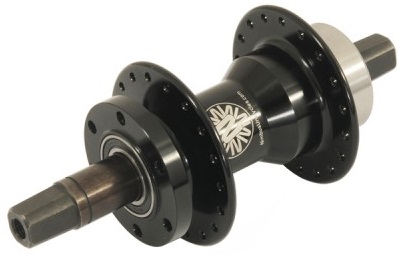
Summary
This hub has 100mm bearing spacing, with a square taper axle, and optionally a standard 6 bolt disk brake mount. It comes in black (Nimbus/Madazz) or Orange (Madazz only).
UDC lists a weight of 618g.
Availability
Limited
The Nimbus hubs are no longer in production - some stores still have stock.
Usage
This hub used to be commonly used for building freewheel unicycles due to its reasonable availability from unicycle.com and other suppliers. It also has close enough hub flange dimensions to be used interchangeably in stock Nimbus/KH wheelsets without requiring new spokes.
To use this in a frame designed for ISIS hubs with 42mm bearing holders, you require 1mm shims, or replacement bearings (17x42x12)
Issues
- The clutch in this hub has only 18 points of engagement, which can mean that a moderate amount of pedaling is required before engagement.
- The hub shell is not very thick, and under hard pedaling has been known to crack in half on numerous occasions. Therefore this hub is not generally recommended for use off-road, especially with long cranks and uphill usage.
- The axle is square taper which means a limited number of strong cranks are available and it may not hold up very well over time, especially off-road. This has however not yet been an issue - the hub shell cracks first!
Maintenance
- Bearings don’t last forever - they should be always coated in a light coat of oil or grease to reduce surface corrosion, and they may need replacing every few years depending on riding conditions and distance.
To remove the bearings, both circlips must be removed. Circlip pliers are highly recommended to avoid damage. - The hub should ideally be checked for wear, and cleaned and re-greased regularly to ensure a long and reliable life. This should probably be done every 500-1000 miles with the amount of abuse that unicycling can give to these hubs that were not designed for it. To do this, the non-clutch (disk) side circlip is removed, and the axle can then be lightly knocked out from that side.
To re-install, spin the axle in the freewheel direction while re-inserting and the pawls should automatically retract and slide into the hub shell, then reinstall the circlip. - UDC UK now sells replacement pawls for this hub.
JR Drift Trikes P-Hub
Internals:
Summary
This hub has 100mm bearing spacing, with a square taper axle, and a standard 6 bolt disc brake mount. It comes in black or purple.
This hub has been weighed at 690g.
Availability
Limited
This hub is as far as I know no longer in production. Stock is limited.
Usage
This hub has commonly been used for building freewheel unicycles due to its general superiority over the aforementioned Nimbus/Madazz hub, although the Bicymple hub is expected to be a superior choice in the future. It has close enough flange dimensions to be used interchangeably in stock Nimbus/KH wheelsets without requiring new spokes.
To use this in a frame designed for ISIS hubs with 42mm bearing holders, you require 1mm shims, or replacement bearings (17x42x12).
Issues
- The clutch in this hub has only 24 points of engagement, which although better than other hubs, can mean that a moderate amount of pedaling is required before engagement.
- The hub flanges are very close together, which means that larger wheels especially have limited strength compared to a standard unicycle wheel. So far this has not been an issue even on wheels up to 32" (ridden on road), but is something to bear in mind.
Maintenance
- Bearings don’t last forever - they should be always coated in a light coat of oil or grease to reduce surface corrosion, and they may need replacing every few years depending on riding conditions and distance.
To remove the bearings, both nuts must first be removed. The disk side nut is right hand thread, and the clutch side nut is a left hand thread (reverse thread). - The hub should ideally be checked for wear, and cleaned and re-greased regularly to ensure a long and reliable life. This should probably be done every 500-1000 miles with the amount of abuse that unicycling can give to these hubs that were not designed for it. To do this, the non-clutch (disk) side nut is removed, and the axle can then be lightly knocked out from that side.
To re-install, spin the axle in the freewheel direction while re-inserting and the pawls should automatically retract and slide into the hub shell, then tighten up the disk side nut (a spanner can be used carefully on the square taper axle as something to tighten up against).
Onyx Racing Drift Trike Hub
Summary
Onyx Racing makes Sprag Clutch bicycle hubs, and briefly made a short run of square taper drift trike hubs with sprag clutches.
Presumed to be 100mm spacing and standard 17x40x12 bearings for square taper hubs.
Expensive when available ~$500, and unavailable without a new order with MOQ of likely >5 units
Availability
None
No longer in production, never seen second hand.
They apparently could make us ISIS ones, but they’d come in at >$700 with a MOQ of 10 units.
DIY Hubs/unusual freewheel unicycles:
DIY Freewheel Hub - AWS
@aws has made his own ISIS freewheel hub with two sprag clutch bearings:
Not a unicycle:
MC² Transformer Bike
This is an interesting bike that first appeared in 2014 as a crowdfunding campaign, went on to full production, then the company went quiet more recently.
Most interesting to us unicyclists is the front wheel, complete with a two speed geared freewheeling hub.
The bearing spacing is unknown, but it’s presumed to be close to 100mm, and it appears to use standard 17x40x12 square taper axle bearings.
The shifting appears to work by means of a free-spinning planetary gear set (for 1:1), with an outer ring gear that’s locked in place to go to the high gear (1:3). In the prototypes this locking mechanism was a secondary disk brake, but the finished products appear to possibly use some kind of drum brake or enclosed disk arrangement.
With some imagination, one can see how this same idea could be used to create a freewheeling/fixed hub complete with hand controlled shifter. If there is enough modulation in the “gear changer” then this could potentially be used as a rudimentary CVT, or at least allow you to slowly change gear rather than jump from 1:1 to the slightly insane seeming 1:3.
The gear change is demonstrated in this video: https://www.youtube.com/watch?v=3H0yx-0o22Y
MC² DRIVING WHEELSET (website seen working still in July 2021, dead in 2022)
Bellcycle
This is another crowd-funded product that went on to full production, but it was only ever sold as a kit of parts.
It utilizes an extra wide square taper axle complete with chain drive in a similar manner to some DIY geared unicycles but with a freewheeling sprocket connected to the driving wheel.
http://bellcycles.com/ (website working Jan 2021)
Kervelo Bicycle Hub
This was a hub designed for a recumbent bicycle by the company Kervelo.
It consisted of a Pinion P-line gearbox with single sided mount and a huge custom cage hub and wheel surrounding it.
This never looked like it would be the strongest design around, but it was a fascinating concept and it presumably worked on a recumbent!
It used ISIS cranks, would have been at least 2.7KG (the weight of a Pinion gearbox), and due to the single sided mount, almost certainly not strong or stiff enough to ride as part of a unicycle.
Kervelo kernel-hub
Following the apparent success of their previous hub prototype with a Pinion gearbox, Kervelo then went on to create the Kernel Hub, a 6/12 speed internally geared hub complete with ISIS cranks and pretty normal looking spacing, but with a somewhat unusual looking mounting setup.
Sadly despite apparently going into production, this disappeared as fast as it appeared and it never seems to have actually been sold.
Blog - kervelo- ร่วมสนุกและเพลิดเพลินกับสล็อต PG และคาสิโนออนไลน์ที่ไม่เหมือนใคร! (web-page no longer exists - 2021)
Bicymple
Another front wheel drive bicycle that went into production, using either a freewheeling Schlumpf 2 speed hub, or their own custom made ISIS 1:1 freewheel hubs.
https://shop.bicymple.com/products/bicymple-penny-farthing (Website working Jun 2021)
Unibike
A number of BMX riders over the years have removed the rear of a bike with front stunt pegs to create a “unibike”.
This is what we’d call a peg freewheel now, but with handlebars instead of a seat.
History, notable, and showcase
Historical discussion threads:
Freewheel Unicycle - 2006
26" freewheeling unicycle - 2007
Freewheeling KH24 - 2007
Freewheel hub design - 2008
Freewheel 36er - 2013
Adventures in Freewheeling - 2013
Riding Videos:
Offroad/Downhill
Freewheeling the Anza Trail, 36" Edition - Carl Hunt - February 2013 [YouTube]
Downhill Dream - Carl Hunt - April 2014 [YouTube]
Unicycle Freewheel - Tibo Waza - June 2016 [YouTube]
Ben Soja - Jan 2018 [YouTube]
Coasting Duthie Hill - AJ Kinsella-Johnson - Jan 2018 [YouTube]
Almaty Trail 2019 - Dmitry Bibichkov - Aug 2020 [Instagram]
Freewheel Revolution - Rebekka Wiedener - Jan 2021 (Qu-Ax prototype hub) [YouTube]
Jumps/rollers
Small Jump Practice - Carl Hunt - May 2014 [YouTube]
No pedaling - AJ Kinsella-Johnson - July 2019 [YouTube]
Big jumps - AJ - Feb 2020 [Instagram]
Landing jumps - AJ - March 2020 [Instagram]
Progress on the freewheel - Samuel Mößner - October 2020 [Facebook]
Urban/Skatepark
Tibo Waza - January 2018 [YouTube]
Something different - Mimo Seedler - October 2021 [Instagram]
Road/Distance
32" à roue libre au Grand Roquet - Simon Jan Du Voyage - Nov 2016 [YouTube]
Freewheel unicycle training in my street - Simon Jan Du Voyage - Dec 2017 [YouTube]
J’ai croisé le Père Noël à Saint-Malo - Simon Jan Du Voyage - Jan 2021 [YouTube]
Other
3.8x Geared Freewheel - Carl Hunt - March 2015 (JR Game Changer Drift Trike Hub) [YouTube]
Peg Unicycling - Carl Hunt [YouTube Playlist]
Freewheel Unicycling - General - Carl Hunt - [Youtube Playlist]
[Last updated: Feb 14th, 2023]

